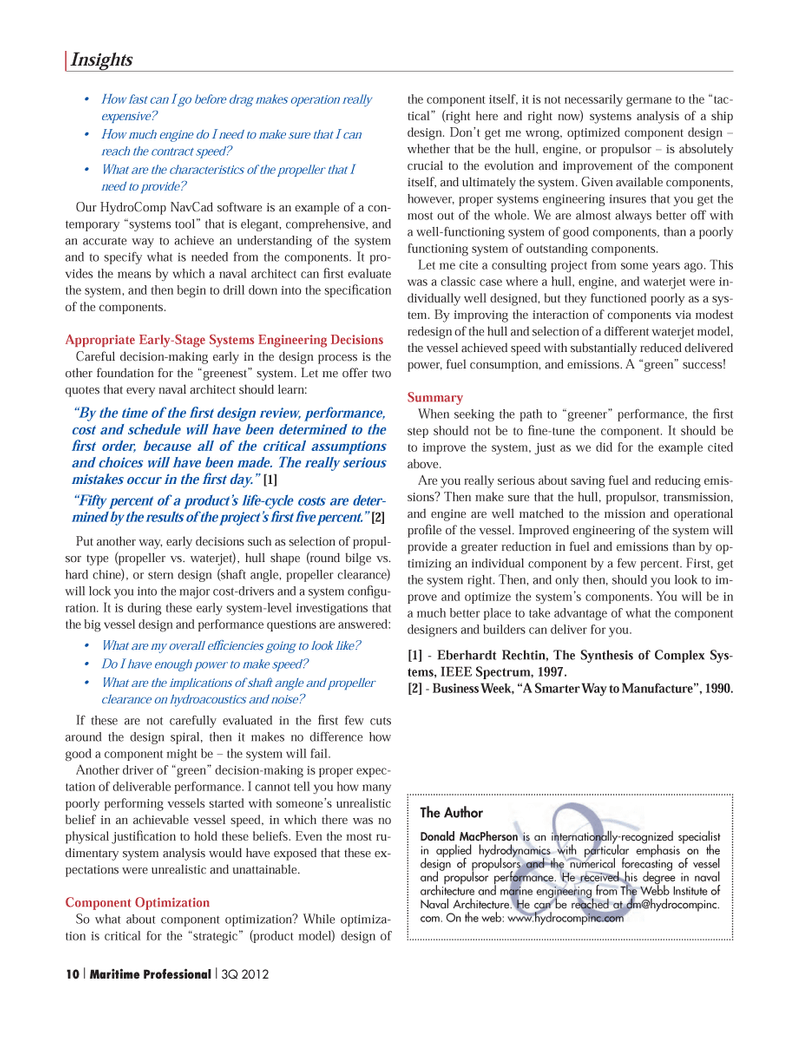
Page 10: of Maritime Logistics Professional Magazine (Q3 2012)
Classification Societies, Quality & Design
Read this page in Pdf, Flash or Html5 edition of Q3 2012 Maritime Logistics Professional Magazine
Insights How fast can I go before drag makes operation really expensive? How much engine do I need to make sure that I can reach the contract speed? What are the characteristics of the propeller that I need to provide? Our HydroComp NavCad software is an example of a con- temporary ?systems tool? that is elegant, comprehensive, and an accurate way to achieve an understanding of the system and to specify what is needed from the components. It pro-vides the means by which a naval architect can rst evaluate the system, and then begin to drill down into the speci cation of the components.Appropriate Early-Stage Systems Engineering Decisions Careful decision-making early in the design process is the other foundation for the ?greenest? system. Let me offer two quotes that every naval architect should learn: ?By the time of the rst design review, performance, cost and schedule will have been determined to the rst order, because all of the critical assumptions and choices will have been made. The really serious mistakes occur in the rst day.? [1]?Fifty percent of a product?s life-cycle costs are deter- mined by the results of the project?s rst ve percent.? [2]Put another way, early decisions such as selection of propul- sor type (propeller vs. waterjet), hull shape (round bilge vs. hard chine), or stern design (shaft angle, propeller clearance) will lock you into the major cost-drivers and a system con gu-ration. It is during these early system-level investigations that the big vessel design and performance questions are answered: What are my overall ef ciencies going to look like? Do I have enough power to make speed? What are the implications of shaft angle and propeller clearance on hydroacoustics and noise? If these are not carefully evaluated in the rst few cuts around the design spiral, then it makes no difference how good a component might be ? the system will fail. Another driver of ?green? decision-making is proper expec- tation of deliverable performance. I cannot tell you how many poorly performing vessels started with someone?s unrealistic belief in an achievable vessel speed, in which there was no physical justi cation to hold these beliefs. Even the most ru- dimentary system analysis would have exposed that these ex- pectations were unrealistic and unattainable.Component OptimizationSo what about component optimization? While optimiza- tion is critical for the ?strategic? (product model) design of the component itself, it is not necessarily germane to the ?tac-tical? (right here and right now) systems analysis of a ship design. Don?t get me wrong, optimized component design ? whether that be the hull, engine, or propulsor ? is absolutely crucial to the evolution and improvement of the component itself, and ultimately the system. Given available components, however, proper systems engineering insures that you get the most out of the whole. We are almost always better off with a well-functioning system of good components, than a poorly functioning system of outstanding components.Let me cite a consulting project from some years ago. This was a classic case where a hull, engine, and waterjet were in- dividually well designed, but they functioned poorly as a sys- tem. By improving the interaction of components via modest redesign of the hull and selection of a different waterjet model, the vessel achieved speed with substantially reduced delivered power, fuel consumption, and emissions. A ?green? success! SummaryWhen seeking the path to ?greener? performance, the rst step should not be to ne-tune the component. It should be to improve the system, just as we did for the example cited above. Are you really serious about saving fuel and reducing emis- sions? Then make sure that the hull, propulsor, transmission, and engine are well matched to the mission and operational pro le of the vessel. Improved engineering of the system will provide a greater reduction in fuel and emissions than by op- timizing an individual component by a few percent. First, get the system right. Then, and only then, should you look to im- prove and optimize the system?s components. You will be in a much better place to take advantage of what the component designers and builders can deliver for you. [1] - Eberhardt Rechtin, The Synthesis of Complex Sys- tems, IEEE Spectrum, 1997.[2] - Business Week, ?A Smarter Way to Manufacture?, 1990. The Author Donald MacPherson is an internationally-recognized specialist in applied hydrodynamics with particular emphasis on the design of propulsors and the numerical forecasting of vessel and propulsor performance. He received his degree in naval architecture and marine engineering from The Webb Institute of Naval Architecture. He can be reached at [email protected]. On the web: www.hydrocompinc.com 10 I Maritime Professional I 3Q 2012MP #3 1-17.indd 10MP #3 1-17.indd 108/14/2012 5:03:53 PM8/14/2012 5:03:53 PM

 9
9

 11
11
